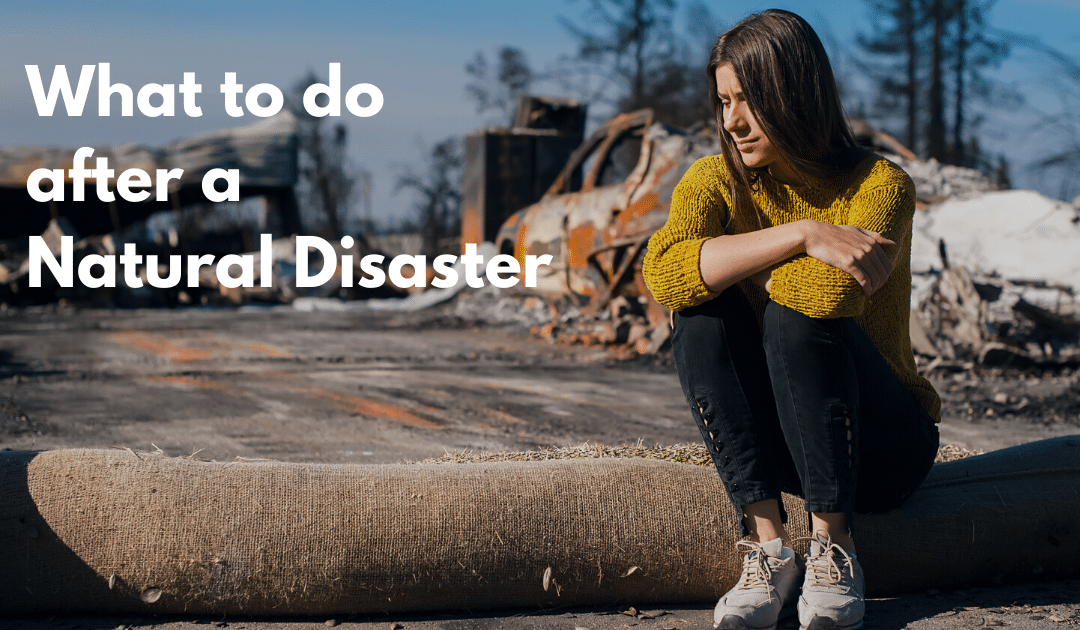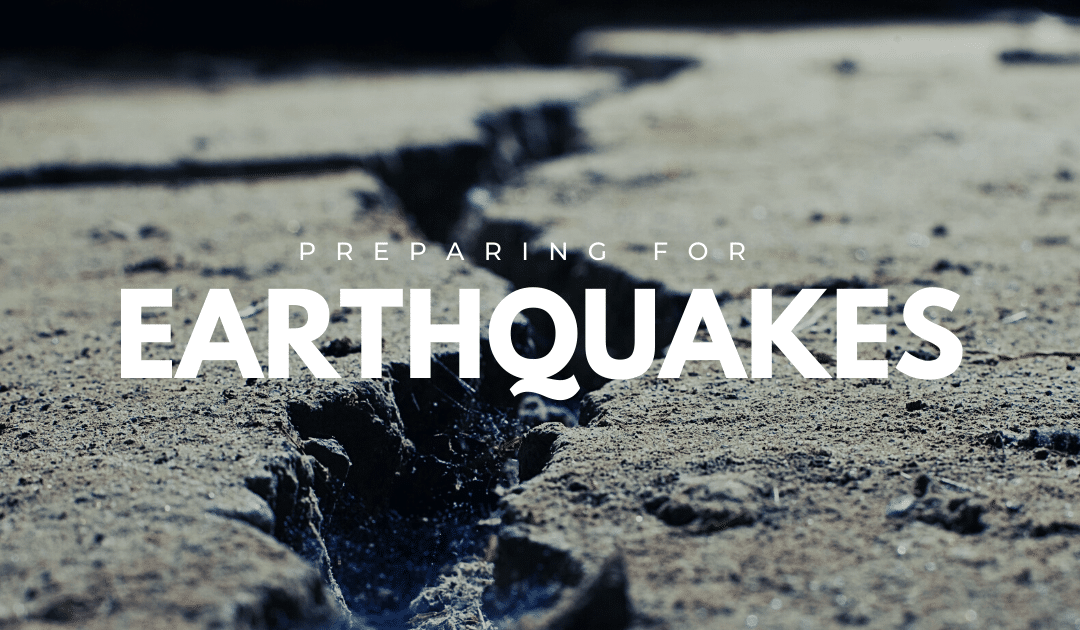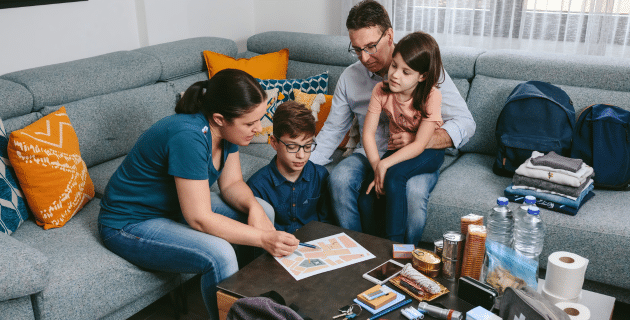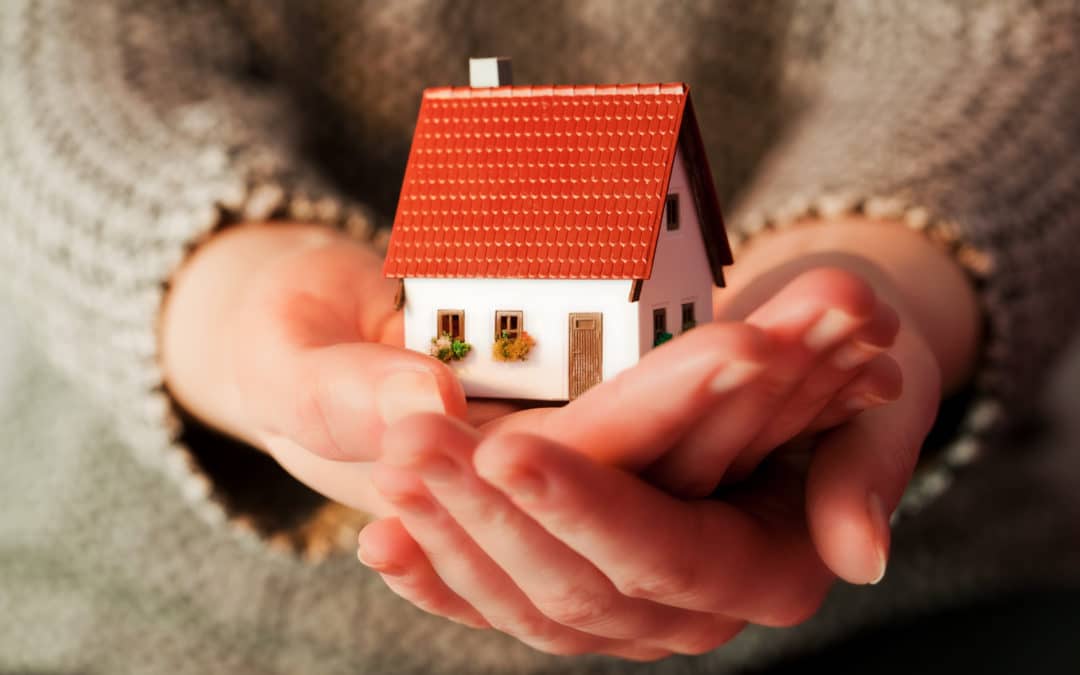
by California Casualty | Good to Know |
Whether it’s a flood, tornado, hurricane or earthquake, a natural disaster can turn your world upside down in a matter of seconds. Besides stress, adrenaline, and fear, there may be injuries to deal with and damage or loss of property. Many people don’t know what to do in the wake of a disaster, which can hinder their coping efforts and recovery.
Here’s a list of the 6 main steps to take immediately following a natural disaster and in the days, weeks, and months that follow.
- Deal with the Immediate Aftermath
-
-
- Make sure all household members are accounted for. If anyone is missing, seek help from first responders.
- Attend to physical injuries or emotional distress. In cases of serious injury, summon professional help.
- If you and your family need to evacuate, follow your family’s evacuation plan, grabbing emergency kits, go bags, and essentials as assigned.
- Notify family and friends that you’re safe. If you can’t connect directly, you can register with FEMA’s emergency family locator online or by calling 1-800-588-9822. See more FCC & FEMA communication tips here.
- Be aware of any new safety issues created by the disaster, such as damaged roads/bridges, chemical spills, downed power lines, and washed-out roads. Inform local authorities if possible.
- Find Temporary Shelter or Housing
-
-
- If your home is damaged and rendered uninhabitable, take photos of the damage, remove any valuables you can, and secure the property. Call your insurance company as soon as you’re able.
- If you need to find an open emergency shelter near you right away, you can text SHELTER and your 5-digit zip code to 4FEMA. You can also use the FEMA Mobile App.
- gov also has shelter resources online.
- If you need to secure a hotel or other short-term housing, check FEMA’s resources for interim housing.
- Remember that COVID-19 safety and health precautions may still be in effect so be sure to protect yourself and your family and stay informed on general guidelines.
- If you have a pet, be sure to ask all sheltering or housing inquiries if pets are allowed.
- Keep all your receipts from temporary housing costs, as you can most likely submit them for reimbursement.
- Emergency Food and Water
-
-
- Listen to local radio or television to find disaster feeding sites.
- Check with local agencies, emergency shelters, and food banks for food assistance.
- If you have to boil or otherwise disinfect water, follow the proper guidelines.
- Seek Disaster Assistance
-
-
- Check local radio and media for information on housing, food, first aid, clothing, and financial assistance.
- The American Red Cross, Salvation Army, and other volunteer organizations also provide assistance, supplies and help with clean-up efforts.
- FEMA helps homeowners and renters who have lost their homes as a result of a presidentially-declared disaster. Assistance includes temporary housing, counseling, low-interest loans and grants, and other assistance. Register at gov or call 1-800-621-FEMA. You’ll need your:
-
- social security number
- telephone number
- insurance information, address (location of damaged home and current address)
- total household annual income
- routing and account number for bank account
- a description of damage and losses
- Returning Home
-
-
- Wait until your area is declared safe.
- If returning at night, use a flashlight to inspect your home and property. Keep an eye out for animals, including dangerous ones such as venomous snakes.
- Inspect the property and perimeter first, checking for hazards such as gas leaks, downed power lines, and structural damage. Do not enter if you smell gas, see floodwaters, or if there’s fire damage.
- If you do enter your home, you’ll need to be extremely cautious. Follow the dos and don’ts of inspecting your home in FEMA’s guide here.
- Replacing Lost Records & Protecting Your Property
-
-
- Ideally, your important records and financial documents were part of your emergency kit.
- If you need to replace records such as birth certificates, driver’s licenses, marriage certificates or social security cards, follow the instructions at USA.gov here.
- Contact your creditors to inform them of the situation and work with them for current and ongoing payments.
- If the disaster is a declared Federal disaster, you may be eligible for federal income tax deductions. Check with your tax planner.
- If a member of your family is injured and you’re caring for them, check with your employer to see if you’re eligible for the Family Medical Leave Act or disability benefits.
While checklists and logistical aspects all need to be dealt with, also keep in mind the mental toll that natural disasters exert. Seek help if you can, take breaks and walks, and practice self-care. Remember that children are especially affected. Community and support networks are especially important in times like these — lean on them when you need support, and offer help to others when you have some extra energy to give.

by California Casualty | Homeowners Insurance Info, Safety |
Chances are good that if an earthquake hits, you’ll be at home — especially now, when many of us are working at home due to coronavirus.
Luckily, there are simple things you can do today to safeguard your home and better protect yourself and your family before an earthquake strikes. Start with our 12 to-dos below. You’ll also find 3 top tips for what to do during a quake and, just as importantly, what not to do.
Inside Your Home
Whether it’s the kind that rolls in waves or arrives with a sudden jolt, an earthquake will surely shake your home and its contents. More people are injured by falling objects or furniture than by building damage. Make your home safer by securing and moving furniture and accessories, especially where people sit, sleep, or spend a lot of time. Pay special attention to heavy objects: move them lower to ground level and also make sure they’re not close to escape routes or doorways. Here are 12 other items to check and secure:
-
- Bookshelves – Tall bookshelves are an accident waiting to happen, as they’re unstable to begin with, and their contents can easily become airborne. Secure them to a wall stud using L-brackets and place the heaviest items on bottom shelves.
- Chemicals – If you have chemicals stored on open shelves in the garage or basement, protect them against spills by installing wood, plexiglass strips or wires to restrain them. If containers are behind cabinet doors, use latches to secure the doors.
- Display Cases – Secure these to the floor using appropriate brackets. Install safety glass if possible. Try to secure shelves inside the case as well.
- Electronics – For large electronics such as flat-screen TVs and entertainment centers, buy a “safety strap” kit, which contains straps and buckles designed for these heavy electronics.
- Hanging Objects – These are especially prone to be thrown around in a quake. Framed pictures and mirrors should be hung from closed hooks so they can’t bounce off walls. You can also use earthquake putty to secure corners. Move medium or large-sized pieces so they’re hung on studs, which is more secure being hung on drywall only. Make sure any hanging plants are well away from windows.
- HVAC Units – Anchor units using restraint brackets or seismic snubbers.
- Kitchen Cabinets – Shaking can cause cabinet doors to fly open and throw contents onto the floor. This can lead to a floor full of glass and ceramic shards – not to mention damage to countertops and walls. Secure cabinets by installing one or more of several latches: hook and eye, standard latch, pull/throwover, push latches, child-proof, or seismolatch.
- Piping – Secure all overhead pipes using brackets.
- Refrigerator – Secure refrigerators and other major appliances to wall studs using earthquake appliance straps.
- Space Heaters – These should be equipped with support legs and properly spaced angles. Learn online to DIY or hire a professional.
- Suspended AC Units – These should be braced with angles or welded to a support rod.
- Water Heater – Proper fastening involves having 2 straps that wrap completely around the unit and are screwed into studs of the wall.
What to Do During a Quake
The more you move or try to run during an earthquake, the greater chance you’ll be injured by falling or flying objects. Instead, remember to:
1. Drop to hands and knees – Do this before the earthquake knocks you down. It protects you from being thrown down and allows you to move if you need to.
2. Cover your head and neck – Get under a sturdy table or desk as soon as you can. If you can’t get to one, get next to low-lying furniture that won’t fall on you or next to an interior wall. Wherever you end up, cover your head and neck for protection.
3. Hold on to your shelter – Hold on to the table or desk (or your head and neck) until the shaking stops. If you’re under a table, be ready for it to shift as the quake rolls – and move with it.
What NOT to Do
1. Run outside – A building’s exterior walls are the most dangerous place to be during a quake. Facades, windows, and architectural details are often first to collapse or break. If you’re inside, don’t run outside, and if you’re outside, don’t run inside – crossing the building exterior puts you at risk of being injured by falling debris.
2. Stand in a doorway – It’s a long-held idea that a doorframe is the safest place to be. In modern homes, a doorframe is no safer than any other part of the house and won’t protect you from airborne or falling objects. You’re safer under a sturdy table.
3. Get in the “triangle of life” – An email that’s gone viral in the last few years offers advice counter to the long-established “Drop, Cover and Hold On” advice. The actions outlined have been discredited as potentially life-threatening by experts and their organizations.
Earthquake safety really boils down to preparation. Although you can’t control where you’ll be when one hits, you can prepare yourself and your home starting right now. Between the tips above – and our articles on what to do before and after a quake and emergency kit basics – you’ll be well on your way to pro-level preparation.
This article is furnished by California Casualty, providing auto and home insurance to educators, law enforcement officers, firefighters, and nurses. Get a quote at 1.866.704.8614 or www.calcas.com.

by California Casualty | Homeowners Insurance Info, Safety |
An earthquake, flood, fire, or severe storm can strike at any time — and you and your family may not be together when it does.
How will you find each other if separated? What about household members who have medical conditions? And what if your cell phones or networks are out of power?
Crafting an emergency plan before a disaster hits gives you time to discuss your family’s needs and circumstances, review possible scenarios, and decide on the best options together. Schedule a time when the whole family can participate. You may need one or two additional meetings to finalize all the details.
Here’s what you’ll need to cover:
1. Make A Plan of Action
Smart planning entails talking through a number of situations and “what-ifs.” Start by brainstorming around the following (and remember that coronavirus may affect some answers).
- What natural disasters are we most likely to experience?
- How will we receive emergency alerts and warnings?
- What are the escape or evacuation routes from our house?
- What is our shelter plan?
2. If Your Family is Separated
Re-opening across the country means parents may be going back to work and kids back to school. Are there other locations, such as after-school programs, childcare, gyms or volunteer sites that family members regularly attend? Consider those when answering the following:
- If separated during an emergency, where should we meet near our home?
- If meeting near home is impossible for some or all family members, what’s our meeting place?
- If we are separated, who is our emergency contact outside of our immediate area?
3. Specific Needs of Family Members
Remember to tailor your plan to address any particular needs of/by family members, such as:
- Medical needs including prescriptions and equipment
- Dietary needs
- Medical conditions, disabilities or functional needs, especially those requiring devices and equipment
- Language barriers or limitations
- Ages of all household members, including school-aged children
- Pets or service animals
- Religious and cultural considerations
5. Fill Out the Plan
After discussing the above, it’s time to get it all down on paper. Be sure to capture the following as well.
- All the contact information for each household member.
- Who’s responsible for what during the disaster? Tasks might include things like retrieving the disaster kit, evacuating pets, and fielding disaster updates and alerts.
- Create a personal network of friends, family or neighbors for things you might need help with.
- Make sure you have one or more out-of-town contacts for emergencies.
- Numbers for important contacts such as utilities, financial companies, childcare and caregivers, veterinarians, and insurance companies.
6. Share & Practice
During an emergency, cellular networks and wi-fi may be unreliable, and computers and phones may be lost or out of power. In these cases, having a paper copy of your family disaster plan can save precious time, minimize stress and prevent unnecessary emergencies. So, make sure each family member has a copy and carries it with them in a purse, backpack or work bag (here’s a template plan that fits in your wallet). Have regular family meetings to review the plan and practice. Finally, do a thorough review every 6 months or so, to update information or responsibilities.
7. Resources
Check out these resources to get your plan disaster-ready.
The perfect time to make a plan is right now. Getting all your family members on board and in the know sooner rather than later will ensure that you’re all ready when you need to be.
This article is furnished by California Casualty, providing auto and home insurance to educators, law enforcement officers, firefighters, and nurses. Get a quote at 1.866.704.8614 or www.calcas.com.

by California Casualty | Auto Insurance Info, Homeowners Insurance Info |
Although it is recommended to review your home and auto insurance policies yearly, 60% of all Americans are underinsured and/or don’t understand their policies. Do you know what’s really covered with your insurance policy?
If you don’t or you have any doubts, now is a great time to get an annual review of your auto and home/renters insurance policies. You’ll sleep better at night knowing you are protected against expected surprises if you have a claim. You may also find you are eligible for additional savings and discounts!
Here are seven examples of why you should contact your insurance advisor to review your policy:
- You got married. Newlyweds often pay less for insurance than when they were single. You can also find discounts by combining your autos with one insurance company. It also means all those expensive wedding gifts you received might need extra protection.
- You got divorced. You probably are no longer sharing a vehicle and moved into a different residence. You’ll need to inform your insurance company to set up separate auto and home or renters insurance policies.
- Your teen got a driver’s permit or license. You need to let your insurance company know if they are driving your vehicles, or if you bought them one. Make sure that you take advantage of good student discounts and additional multi-vehicle savings!
- You bought or inherited valuables such as antiques, fine art, jewelry or other collectibles. Your standard homeowners or renters insurance policy provides limited coverage of high dollar items. This is a good time to purchase scheduled personal property endorsements to cover your new valuable possessions for a higher amount.
- You’ve added on to your home or have remodeled. Improvements to your house mean there is more to protect. Contacting your insurance company is a good way to make sure that you have enough coverage. This also applies for a new gazebo, shed or pool, or hot tub.
- You’ve moved to a flood or earthquake prone area. Neither earthquake nor flood insurance is included with most homeowners or renters policies. You need to purchase separate flood or earthquake insurance. Keep in mind that flood insurance has a 30-day waiting period before it becomes effective.
- You’ve retired. This often means you are driving less, which could significantly reduce your insurance costs. Drivers over 55 also often get discounts from their insurance companies and you can further reduce your premiums by completing a driver safety course.
Knowing more about your insurance could save you money on your premiums and heartache in the event of a break-in or natural disaster.
If it is time for your auto or home insurance coverage review contact one of our customer care advisors today at 1.800.800.9410. A few minutes of your time will provide the appropriate protection, and we may even find you some extra savings!
If you don’t know where to start to determine if it’s time for your policy review, download our free Insurance Coverage Checklist. Just click the image below for your free download!


by California Casualty | Homeowners Insurance Info |
You may believe that everything in or around your home is covered by your homeowner’s policy, but that may not be the case. Sure home insurance will help you rebuild if there’s a fire, tornado. or a tree falls onto your home, but are you aware of what your...






